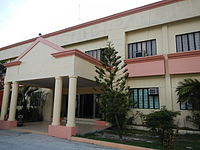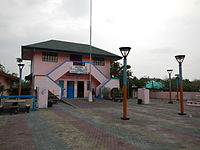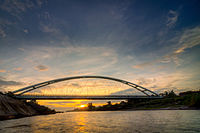Bamban | |
|---|---|
| Municipality of Bamban | |
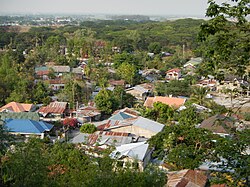 Panoramic of Bamban | |
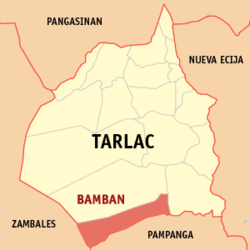 Map of Tarlac with Bamban highlighted | |
Location within the
Philippines | |
| Coordinates: 15°16′27″N 120°34′01″E / 15.2742°N 120.5669°E | |
| Country | Philippines |
| Region | Central Luzon |
| Province | Tarlac |
| District | 3rd district |
| Founded | June 6, 1710 |
| Barangays | 15 (see Barangays) |
| Government | |
| • Type | Sangguniang Bayan |
| • Mayor | Alice L. Guo |
| • Vice Mayor | Leonardo d.C Anunciacion |
| • Representative | Noel N. Rivera |
| • Municipal Council | Members |
| • Electorate | 45,008 voters ( 2022) |
| Area | |
| • Total | 251.98 km2 (97.29 sq mi) |
| Elevation | 89 m (292 ft) |
| Highest elevation | 265 m (869 ft) |
| Lowest elevation | 48 m (157 ft) |
| Population (2020 census)
[3] | |
| • Total | 78,260 |
| • Density | 310/km2 (800/sq mi) |
| • Households | 17,695 |
| Economy | |
| • Income class | 2nd municipal income class |
| • Poverty incidence | 10.30 |
| • Revenue | ₱ 244.7 million (2020) |
| • Assets | ₱ 521.7 million (2020) |
| • Expenditure | ₱ 246.1 million (2020) |
| • Liabilities | ₱ 79.01 million (2020) |
| Service provider | |
| • Electricity | Tarlac 2 Electric Cooperative (TARELCO 2) |
| Time zone | UTC+8 ( PST) |
| ZIP code | 2317, 2023 (portions under
Clark Freeport and Special Economic Zone) |
| PSGC | |
| IDD : area code | +63 (0)45 |
| Native languages | Kapampangan Tagalog Ilocano |
| Website |
bambantarlac |
Bamban, officially the Municipality of Bamban ( Kapampangan: Balen ning Bamban; Filipino: Bayan ng Bamban), is a 2nd class municipality in the province of Tarlac, Philippines. According to the 2020 census, it has a population of 78,260 people. [3]
History
Long before settlers came, the place which was to become the town of Bamban, was a vast track of wild land extending eastward; and on the west side, composed of foothills and mountains lush with vegetation and tall trees extending deep into the Zambales ranges. The thick forest and mountains were then inhabited by the Aetas (locally known as Baluga), and the Zambal, both of whom subsisted only on fishing and native or wild animals which abounded in the place. Occasionally, daring traders from Pampanga and the Tagalog province, mostly enterprising Chinese, braved the wilderness to go northward to Capas and Tarlac.
Before the advent of the Spanish era, small settlers came, attracted by the fertile land and the glittering silver of the river that cut through the mountain to spill down the flat land, making it fertile. The settlers started small clearings in the thick growth of bamban plants which covered vast portions of the land bordering the river a small distance from the foothills.(because of these plants, the place was eventually named Bamban).
Settlers upon settlers came to carve clearings in the land, and soon a small community was formed. About 1700, Augustinian Recollects came and established the Mission de Pueblos de Bamban. But the pueblo was then a part of Pampanga. In 1837, a new boundary line was established, thereby permanently making Bamban part of the province of Tarlac.
Official recognition as a town was sanctioned by the gobernadorcillo in the town of Tarlac. Don Martín Sibal was subsequently appointed head and commissioned with the rank of "Capitán". Among the first settlers were the Sibal, Lugtu, Dayrit, Macale, Vergara, Manipon, and de la Cruz clans.
During the revolution of 1896, Bamban was one of the first towns to take up arms against the Spaniards. Northwest of the town situated among the hills are remnants of strongholds built by brave bands of Bambanenses who joined Gen. Servilliano Aquino in the uprising in Tarlac. Up to this time, a portion of the foothills in the area is called "Batiawan" or look-out point. Many a brave son died in this movement for liberation.
When the Americans came in 1900, the small pueblo gradually grew into a teeming town. The Bamban Sugar Central was established and further gave impetus to its growth. Don Pablo Lagman was the first to be appointed presidente and Don Laureano Campo as vice-presidente under the American military government. Other prominent families then took over the helm of government. During the Commonwealth era, the Sibals, the Lumboys, the Santoses, the Punsalangs, to mention a few, enjoyed political power until the outbreak of World War II.
Bamban was like the legendary phoenix, which locals felt must be resurrected from its ashes. The whole población was devastated and burned during the liberation. Undaunted, the people returned from hiding and began rebuilding even while the campaign was raging deep in the mountains. Growth was fast because of proximity of Clark Air Base. But Bamban can not be the same again. The aftermath of the war was felt for a long time. Consequently, prominent families left the town for the city to establish big business and names for themselves.
The 1991 Mount Pinatubo volcanic eruption and the subsequent flow of lava and mud to the lowlands of Bamban forced residents to move out or to stay at the Dapdap Resettlement Area, which is on higher grounds.
Geography
The municipality of Bamban is the southernmost gateway of the melting pot province of Tarlac in the Central Plain of Luzon in the Philippines.
Being the southernmost town in the province, it has a common boundary with Mabalacat, Pampanga, and in the west, with Zambales. The boundary is defined by the Parua River, which is a source of irrigation water, food, and sand and gravel for infrastructure projects. The mountainous region situated in the western part comprises almost two-thirds of the total land area, which used to be within the US Military Reservations. Nestled in this part are the BLISS projects and to the north, the MAR settlement project, which when completely developed will be a source of livelihood and food supplies for Central Luzon.
Bamban is 99 kilometres (62 mi) from Manila and is 25 kilometres (16 mi) from the provincial capital, Tarlac City.
Barangays
Bamban is politically subdivided into 15 barangays. [5] Each barangay consists of puroks and some have sitios.
- Anupul
- Banaba
- Bangcu
- Culubasa
- Dela Cruz
- La Paz
- Lourdes
- Malonzo
- San Nicolas ( poblacion)
- San Pedro
- San Rafael
- San Roque
- San Vicente
- Santo Niño
- Lumang kalsada
- Virgen de los Remedios (Pacalcal)
Climate
| Climate data for Bamban, Tarlac | |||||||||||||
|---|---|---|---|---|---|---|---|---|---|---|---|---|---|
| Month | Jan | Feb | Mar | Apr | May | Jun | Jul | Aug | Sep | Oct | Nov | Dec | Year |
| Mean daily maximum °C (°F) | 30 (86) |
31 (88) |
33 (91) |
35 (95) |
33 (91) |
31 (88) |
30 (86) |
29 (84) |
29 (84) |
30 (86) |
31 (88) |
30 (86) |
31 (88) |
| Mean daily minimum °C (°F) | 19 (66) |
19 (66) |
20 (68) |
22 (72) |
24 (75) |
24 (75) |
24 (75) |
24 (75) |
23 (73) |
22 (72) |
21 (70) |
20 (68) |
22 (71) |
| Average precipitation mm (inches) | 3 (0.1) |
2 (0.1) |
5 (0.2) |
10 (0.4) |
80 (3.1) |
107 (4.2) |
138 (5.4) |
147 (5.8) |
119 (4.7) |
70 (2.8) |
26 (1.0) |
8 (0.3) |
715 (28.1) |
| Average rainy days | 2.0 | 1.7 | 2.7 | 4.6 | 16.1 | 20.8 | 24.0 | 23.0 | 21.4 | 15.5 | 8.0 | 3.2 | 143 |
| Source: Meteoblue [6] | |||||||||||||
Demographics
|
| |||||||||||||||||||||||||||||||||||||||||||||||||||
| Source: Philippine Statistics Authority [7] [8] [9] [10] | ||||||||||||||||||||||||||||||||||||||||||||||||||||
In the 2020 census, the population of Bamban, Tarlac, was 78,260 people, [3] with a density of 310 inhabitants per square kilometre or 800 inhabitants per square mile.
Economy
Graphs are unavailable due to technical issues. There is more info on
Phabricator and on
MediaWiki.org. |
Tourism

- At the center of the town is the heritage (F-1812) Santo Niño Parish Church of Bamban
[18] (Vicariate of San Nicolas de Tolentino; Vicar Forane: Msgr. Francisco Tañedo
[19]
- Titular: Santo Niño, Feast, Last Saturday of January
- Parish priest: Father Claro Lacson
- Parochial vicar: Father Melvin Baldos. [20] [21] - San Nicolas, Bamban, Philippines beside the [22] Santo Niño Academy (Bamban, Tarlac) [23] [24] [25] [19] [26] [27] [28] ]. [29] It belongs to the Roman Catholic Diocese of Tarlac. [30]
- Grotto of Our Lady of Lourdes of Bamban at Dolores
- Bamban Caves and the Matayumtayum well was used by General Francisco Macabulos and his troops against the Spaniards and later on by Filipino guerrillas during the Second World War.
Gallery
-
Bamban municipal hall
-
Municipal library, town plaza and police station
-
Public market
-
Bamban Bridge
-
Highway
See also
References
- ^ Municipality of Bamban | (DILG)
- ^ "2015 Census of Population, Report No. 3 – Population, Land Area, and Population Density" (PDF). Philippine Statistics Authority. Quezon City, Philippines. August 2016. ISSN 0117-1453. Archived (PDF) from the original on May 25, 2021. Retrieved July 16, 2021.
- ^ a b c Census of Population (2020). "Region III (Central Luzon)". Total Population by Province, City, Municipality and Barangay. Philippine Statistics Authority. Retrieved 8 July 2021.
- ^ "PSA Releases the 2018 Municipal and City Level Poverty Estimates". Philippine Statistics Authority. 15 December 2021. Retrieved 22 January 2022.
- ^ "Province: Tarlac". PSGC Interactive. Quezon City, Philippines: Philippine Statistics Authority. Retrieved 12 November 2016.
- ^ "Bamban: Average Temperatures and Rainfall". Meteoblue. Retrieved 5 May 2020.
- ^ Census of Population (2015). "Region III (Central Luzon)". Total Population by Province, City, Municipality and Barangay. Philippine Statistics Authority. Retrieved 20 June 2016.
- ^ Census of Population and Housing (2010). "Region III (Central Luzon)" (PDF). Total Population by Province, City, Municipality and Barangay. National Statistics Office. Retrieved 29 June 2016.
-
^ Censuses of Population (1903–2007).
"Region III (Central Luzon)".
Table 1. Population Enumerated in Various Censuses by Province/Highly Urbanized City: 1903 to 2007.
National Statistics Office.
{{ cite encyclopedia}}: CS1 maint: numeric names: authors list ( link) - ^ "Province of Tarlac". Municipality Population Data. Local Water Utilities Administration Research Division. Retrieved 17 December 2016.
- ^ "Poverty incidence (PI):". Philippine Statistics Authority. Retrieved December 28, 2020.
- ^ "Estimation of Local Poverty in the Philippines" (PDF). Philippine Statistics Authority. 29 November 2005.
- ^ "2003 City and Municipal Level Poverty Estimates" (PDF). Philippine Statistics Authority. 23 March 2009.
- ^ "City and Municipal Level Poverty Estimates; 2006 and 2009" (PDF). Philippine Statistics Authority. 3 August 2012.
- ^ "2012 Municipal and City Level Poverty Estimates" (PDF). Philippine Statistics Authority. 31 May 2016.
- ^ "Municipal and City Level Small Area Poverty Estimates; 2009, 2012 and 2015". Philippine Statistics Authority. 10 July 2019.
- ^ "PSA Releases the 2018 Municipal and City Level Poverty Estimates". Philippine Statistics Authority. 15 December 2021. Retrieved 22 January 2022.
- ^ "Category:Santo Niño Parish Church of Bamban - Wikimedia Commons". Commons.wikimedia.org. Retrieved 2019-10-16.
- ^ a b "List of Parishes of the Roman Catholic Diocese of Tarlac | Philippine Churches". Archived from the original on 2012-09-03. Retrieved 2013-05-01.
- ^ "Tarlac churches | mga pahina ni msbolin". Archived from the original on 2016-03-05. Retrieved 2013-05-01.
- ^ "Panoramio - Photo of Santo Nino Parish Church, Bamban, Tarlac". Archived from the original on 2016-10-25. Retrieved 2017-11-01.
- ^ "Sto Nino Academy". Archived from the original on 2013-06-30. Retrieved 2013-05-01.
-
^
"Archived copy". Archived from
the original on 2016-03-03. Retrieved 2013-05-01.
{{ cite web}}: CS1 maint: archived copy as title ( link) - ^ "Santo Niño Parish - Churches & Religious Services - Tarlac". panpages.ph. Archived from the original on 5 July 2013. Retrieved 22 May 2022.
- ^ "Santo Niño Church - Bamban". Wikimapia.org. Retrieved 2019-10-16.
- ^ "Inscribe Tours goes to Tarlac for 'Visita Iglesia'". The Philippine Star. Retrieved 2019-10-16.
- ^ "Things to do and places to visit in Tarlac, Philippines". Localyte.com. Retrieved 2019-10-16.
- ^ "Visita Iglesias de Tarlac". Localyte.com. Retrieved 2019-10-16.
- ^ "Diocese of Tarlac". Archived from the original on 2010-06-17. Retrieved 2013-05-01.
- ^ "Diocese of Tarlac, Philippines". Gcatholic.org. Retrieved 2019-10-16.





